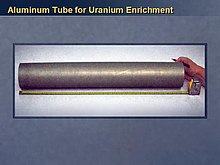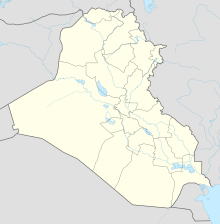Iraqi nuclear program
The Iraqi nuclear program ran from 1975 to 1991; An ability to manufacture nuclear weapons is considered unlikely , according to the then IAEA Director General Mohammed el-Baradei .
Beginnings and Doubts
In 1959 Iraq became a member of the International Atomic Energy Agency. Iraq signed the Nuclear Non-Proliferation Treaty on July 1, 1968 and ratified it on October 29, 1969. A Soviet research reactor with 2 MW (IRT-2000) was put into operation in Tuwaitha in 1968, and in 1978 the reactor was updated to 5 MW (IRT-5000).
The Iraqi nuclear program began on November 18, 1975 with the signing of the Franco-Iraqi nuclear agreement and the purchase of two French reactors. France's Prime Minister Jacques Chirac paid Saddam Hussein a visit to Baghdad as early as December 1974 . Iraq is said to have submitted a request for a UNGG reactor . The Iraqi nuclear program was headed by Dr. Jaffar Dhia Jaffar. From 1976 France built the Tammuz-1 reactor (Eastern Iraq), a light water reactor designed for 40 MW th ; a smaller, second experimental reactor, Tammuz-2 (Isis) with 600 kW th , should also be built. Both containment were on 6 April 1979 three days before the shipment from France to Iraq in La Seyne-sur-Mer in the halls of CNIM damaged by sabotage.
From 1982 Iraq tried to get uranium enrichment under control independently of international obligations and without having its own nuclear reactor. To this end, the Tuwaitha Nuclear Research Center was expanded to include uranium enrichment facilities. In 1984, in Project 182, there was a design for a 40 MW natural uranium reactor of the CANDU type as a replacement for the destroyed Tammuz-1 . The design never got beyond the planning stage.
Military target
On October 30, 1980, at the beginning of the First Gulf War , the Tammuz-1 reactor under construction was the target of the Iranian Air Force in the " Operation Scorch Sword " . During the Israeli " Operation Opera " on June 7, 1981, the reactor , which had not yet been equipped with nuclear fuel , was attacked a second time and severely damaged. The reason for this was that, according to the intelligence services, enough plutonium could have been produced in Tammuz-1 for a possible nuclear weapons program. The United Nations Security Council condemned Israel's conduct in Resolution 487 (1981). During the Second Gulf War , the entire Tuwaitha facility was attacked several times from January 19, 1991 and completely destroyed. Here, too, it was suspected that Iraq would produce highly enriched uranium for a possible nuclear weapons program. Evidence was provided by the large shipments of hundreds of tons of low-enriched uranium and yellow cake from various countries in the period 1980–82. Iraq apparently succeeded in taking the first stages in the fuel cycle from 1985 to 1991 at its facilities in Tuwaitha .

Termination, War and Repatriation
The Iraqi nuclear program apparently ended in 1991. By UN Resolution 687 (1991) of April 8, 1991, Iraq was obliged to have all investigations into the Nuclear Non-Proliferation Treaty carried out. The IAEA carried out extensive inspections from 1991 to September 2007. From 1991 to 1994, the IAEA inspectors found and confiscated 37.5 kg of highly enriched uranium and 5 grams of plutonium in the experimental facilities in Iraq. With uranium enrichment using the gas diffusion method and gas centrifuges , around 640 grams of uranium with an enrichment level of 7.2 percent were produced from Iraq until 1991. In 1992, 6.6 kg of uranium-235 were transferred from the remaining stocks to Moscow. The degree of enrichment of uranium in light water reactors is 3 to 4%. An enrichment level of over 85 percent is typically required to build an atom bomb.
One of the reasons for the Iraq war was that Iraq had tried to buy nuclear weapons-grade uranium in Africa in the 1990s, but this could not be confirmed; Neither is the claim that Iraq attempted to buy aluminum tubes for centrifuges for uranium enrichment from Niger in 2002 .
After the Iraq war , 1.8 tons of low-enriched uranium was transferred to the USA in 2004 and 600 tons of uranium in the form of yellowcake to Canada in 2008 .
Remarks
- ↑ Iraq should accept the resulting hairline cracks or wait 6 months for new containers. The Mossad is suspected to be the originator of the sabotage . Likewise with the attack on the Egyptian nuclear physicist Yahya El Mashad, who was murdered on June 14, 1980 in Paris. He worked for the Iraqi nuclear program. → See: Amos Perlmutter, Uri Bar-Joseph, Michael I. Handel: Two Minutes Over Baghdad , Routledge Chapman & Hall 2003, ISBN 978-071468-347-8
- ↑ Tammuz-1 should go into operation in September 1981. → See: Jacqueline Denis-Lempereur
-
↑ After the Tammuz-1 had been equipped with fuel rods, according to Israeli intelligence reports, Iraq would have extracted around 8 kg of plutonium by the end of 1982 and thus produced a plutonium bomb around 1985. → See: Amos Perlmutter, Uri Bar-Joseph, Michael I. Handel: Two Minutes Over Baghdad , Routledge Chapman & Hall 2003, ISBN 978-071468-347-8
The interpretation of Tammuz-1 with 25 kg of highly enriched uranium, the at full load would only result in an amount of plutonium in the gram range. → See: "The reactor is transparent" . In: Der Spiegel . No. 25 , 1981 ( online - June 15, 1981 ). So also Anthony Fainberg in Bulletin of the Atomic Scientists Oct. 1981, Vol 37, No 8. , p. 33.
- ↑ See: Package Q Strike .
- ↑ Portugal supplied 286 tons and Niger 276 tons of yellow cake, Brazil 24 tons of uranium dioxide .
- ↑ Uranium Oxide → Yellowcake → Uranium Hexafluoride .
- ↑ Iraq received 50 kg of high-enriched uranium (93%) for its reactor from Russia and France (12.5 kg on June 14, 1980) and 1,767 kg of low-enriched uranium from Italy . → See: iaea.org ( Memento of the original from October 25, 2012 in the Internet Archive ) Info: The archive link was inserted automatically and has not yet been checked. Please check the original and archive link according to the instructions and then remove this notice. .
- ↑ Khidir Hamza, a former Iraqi scientist, literally triggered a media hype . In 2002 he stated: "If it is not stopped soon, Saddam will not only have built a few bombs, but will have built up a whole atomic bomb industry." → See: Spiegel.de . → See: Khidir Hamza: Saddam's Bombmaker , 2001, ISBN 978-074321-135-2 . The IAEA's chief inspector in Iraq, David Kay , called for Hamza's book to be required reading for the next American president. → See: Review.
Individual evidence
- ↑ n-tv.de, Sept. 2003, accessed on January 23, 2013
- ↑ un.org Treaty on the Non-Proliferation of Nuclear Weapons
- ↑ iraqwatch.org ( Memento of the original from August 14, 2015 in the Internet Archive ) Info: The archive link was automatically inserted and not yet checked. Please check the original and archive link according to the instructions and then remove this notice. Iraq annual report 1981 , accessed January 23, 2013
- ↑ guardian.co.uk
- ↑ bbc.co.uk Dr. Jaffar Dhia Jaffar , accessed January 24, 2013
- ↑ nti.org (PDF file; 671 kB) iraq nuclear , accessed on January 24, 2013
- ↑ a b UNITED NATIONS Security Council ( Memento of the original from January 20, 2013 in the Internet Archive ) Info: The archive link was inserted automatically and has not yet been checked. Please check the original and archive link according to the instructions and then remove this notice. (PDF file; 429 kB) S / 1997/779 , accessed on January 23, 2013
- ↑ RESOLUTION 487 (1981) ( Memento of the original from March 17, 2013 in the Internet Archive ) Info: The archive link was inserted automatically and has not yet been checked. Please check the original and archive link according to the instructions and then remove this notice.
- ↑ RESOLUTION 687 (1991)
- ↑ iaea.org , accessed January 23, 2013
- ↑ iaea.org ( Memento of the original from October 25, 2012 in the Internet Archive ) Info: The archive link was inserted automatically and has not yet been checked. Please check the original and archive link according to the instructions and then remove this notice. Iraq's Nuclear Weapon Program , accessed January 23, 2013
- ↑ iaea.org ( Memento of the original dated February 2, 2013 in the Internet Archive ) Info: The archive link was inserted automatically and has not yet been checked. Please check the original and archive link according to the instructions and then remove this notice. Retrieved January 23, 2013
- ↑ CIA information about the nuclear program in Iraq was wrong - USA: No evidence of uranium purchase - Premier Blair before committee - dpa via tagesspiegel.de, accessed on January 23, 2013
- ^ New York Times, September 8, 2002 Threats and Responses: The Iraquis; US says Hussein intensifies Quest for A-Bomb Parts
- ↑ US Helps Remove Uranium From Iraq - nytimes.com 2008, accessed January 23, 2013

